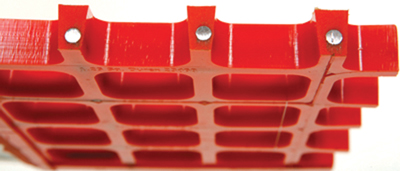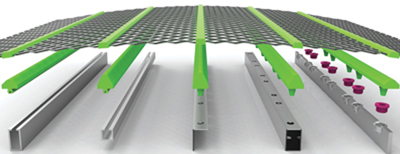PRODUCTION, CONSISTENCY, RELIABILITY AND SAFETY ARE ALL TIED TIGHTLY TO DECISIONS FACILITIES MAKE ON SCREEN SYSTEMS — HERE’S WHAT CUSTOMERS NEED TO KNOW NOW
By Donna Schmidt, Field Editor, and Simon Walker, European Editor
| When sizing screening machines, the first consideration is the application followed by capacity. (Photo courtesy of Tabor) |
Screens: an area that some operations don’t give a significant level of thought to once their chosen system is in place — until wear and age have taken their toll and the myriad of choices in screen selection must become a forefront issue. Coal Age’s sister publication Engineering and Mining Journal recently started an important conversation on the topic of screening systems (see June 2014, pg. 72), pointing out that many discover just how quickly products and technology do change, with manufacturers growing and enhancing product lines rapidly for greater wearability, reliability and efficiency.
Continuing that discussion, Coal Age recently took a poll of some of the biggest considerations for screen selection. Providing an insightful and comprehensive response was John Casey, sales and applications engineer for Elgin Equipment Group Corp.’s Tabor Machine.
“When selecting the screen, the first priority is the application followed closely by the screen tonnage,” he said. “The vast majority of the time, the application will dictate the type of screen needed, i.e., scalping screens are generally Orbital Incline screens.”
He noted that, however, there are variations to everything; a prime example of this would be the deslime and drain and rinse screens.
“Both of these applications could use either a horizontal or a multislope. The horizontal was the mainstay during the early years of coal preparation, and is still common in many plants. The multislope came about by combining the curved sieve and screen into one item following the theory of utilizing a thin bed depth and velocity to help stratify the material.”
It was that move, he noted, that permitted preparation plant designs to utilize the same area that a horizontal screen and sieve combination would occupy and place a multislope in that same area. Where the multislope operates with a higher velocity of material movement, this allows the tonnage to increase up to 70% higher as compared to the horizontal screens.
Certainly food for thought. But what of other factors some sites find to be the key to success? What is a priority for one may not be for another, but there are few — if any — plants that would say that money is no object and costs per ton processed has no bearing on its everyday operation.
Thus, below are just a few of the most significant considerations in making an effective choice for this long-term need.
 |
| Weir Minerals’ Armor polyurethane wire screen media. (Photo courtesy of Weir) |
Taking a Look at Materials
Derrick Corp.’s North America Sales Manager David Perkins, responding to a key query of how screen materials have changed over the past decade, told E&MJ recently that the company has spent the last several years continuing its quest to produce the finest, long-lasting screen panels in the world. Derrick uses its own proprietary blends of urethane materials to achieve a panel that is robust, while maintaining the highest open area available, he said, noting that in 2013, Derrick produced its finest urethane panel yet at 45 µm (325 mesh).
Sandvik responded that it has developed a complete range of screening media over the last 10 years that encompasses modular, reinforced and tensioned panels for applications across the mining industry. Specifically, separation at smaller sizes requires more flexible rubber, while more heavy-duty applications including coarse materials and larger separations require stiffer media. The quality of the rubber is key, with each product needing a high-performance rubber with outstanding mechanical properties, the company said.
Jeff Easton, a principal process engineer for WesTech Engineering, added that, since the mid-2000s, the company has put significant effort into improving its specialty screening products such as its media retention screens. Adsorption carbon as well as newer synthetic resins must be retained in a leach vessel by the inter-stage screen while at the same time allowing the mineral slurry to pass through, he explained.
“Wear on the screen media can be significant, impacting not only longevity but also consistency in the retention aperture over time as well,” he said. “WesTech has combatted these challenges by utilizing a high-wear characteristic alloy and steeper wire wedge angle, allowing its screens to not only resist wear, but also maintain an appropriate aperture range ensuring less loss of near-size value-loaded carbon or resin.”
Speaking for the Canadian company, Major Wire Industries President and CEO Jean Leblond said that high-performance, self-cleaning screen media using polyurethane strips have been achieving increasing market awareness, replacing woven wire on the one hand and polyurethane or rubber on the other. The company’s Flex-Mat 3 eliminates virtually any blinding and pegging, he said, and accelerates stratification due to its independently vibrating wires. “It lasts between three and seven times as long as woven wire, giving up to 50% more higher-quality production,” Leblond said, adding that Flex-Mat 3 produces up to twice as much as polyurethane or rubber media for users looking for more tons per hour.
Les Naday, mining industry manager for Polydeck Screen Corp., explained there has been some improvement in wear resistance and durability because of new formulations that have become available for rubber and polyurethanes. These formulations have proved to be beneficial in specific cases, he said, emphasizing the way in which manufacturers can now tailor their screen media products to meet individual operations’ requirements.
For FLSmidth, company General Manager for Screen Media David Sibley also pointed out that while investigation into improved materials for the manufacture of polyurethane screen panels is ongoing, none of the many materials tested in the last few years have demonstrated qualities over and above the materials currently in use. In addition, the use of high-quality spring-steel frames have enabled modular screen media to achieve a much higher “open area,” with percentages of up to 55%, while reducing the installed mass.
The company has also introduced hybrid modular polyurethane panels using different types of screen media such as wire screens, perforated material and wedge wire to bring different characteristics to modular screening.
 |
| Major Wire helps producers be more flexible by developing a line of crown bar adaptors. (Photo courtesy of Major Wire) |
Screen size vs. TPH?
Tabor’s Casey said that an exclusive tie between screen size and the ton-per-hour benchmark, or the thought that tonnage is based on the size of the screen used, is likely one of the biggest myths still held by coal facilities. While both are important considerations, there is more to making an informed and wise decision than just these two areas.
“The only way to ensure that the screen will ‘efficiently’ handle the tonnage is to look at a size gradation of the material being fed to the screen. While the screen may carry the material, it doesn’t mean that the screen will efficiently size the material.
“Many times I have been asked to size a screen with the tons per hour being the only information provided; while it is possible to base a screen size on theories, that is not the best practice,” he added. “The only way to definitively size the screen is to go through the size gradation along with the screening media to determine the size needed along with the efficiency.”
On the same token, the size of the coal operation that feeds a plant and the amount of throughput it generates should also not be examined exclusively.
“I try to not let the location affect my recommendations in using the correct or optimum screen size or type,” Casey told Coal Age.
“There are times, especially in the international market, where I do tend to pick certain sizes and types based on the representative in that area and the products they stock. I consider this a plus, as our representatives will be servicing them after the sale.
“The tons processed per year had a direct correlation to the screen selection. This is further broken down to the tons per hour processed, which is the way we size all of our equipment.”
At the same time, he noted, the tonnage reporting to the screen is as important as the gradation of the material.
“If a customer is only processing 300 tons per hour, generally the plant would have horizontal screens while the converse would be a high-tonnage plant that would or could have a majority of multislope screens. The higher tonnage allows for the optimization of the multislope screen’s square footage to the feed rate while keeping the total number of screens to a minimum.”
He also said that some customers, having already closely looked at their specific needs, have a preference of screen type for their site; some, already comfortable using horizontal screens, for example, prefer the horizontal option. A screen supplier, even in those cases, can still be a great partner.
“We [Tabor] work with them to optimize the efficiency with these screens by utilizing the best screening media for their application,” Casey said.
 |
| Tabor offers a 6 ft x 12 ft reverse incline screen in its line. (Photo courtesy of Tabor) |
The Role of Costs and Maintenance Levels
Again, virtually no plant operates day to day without some conscious effort to reduce costs, and in today’s coal market and global economy, this has come into focus even further. Awareness of the process and knowledge of the key goals are central, according to the E&MJ respondents.
In terms of what measures operators can take to reduce screening costs, Sandvik suggested that plants make a close study of the process, ensuring to really get what is being aimed for.
“It might be better overall economy to produce a smaller tonnage of higher-quality material than a higher-total tonnage at lower quality,” it said, noting that it is also very important to fully know and understand the process.
“Study the screens very closely; in general, there is a lot of focus on crushers, but screens are allowed to run with very little attention — unless problems occur. Having large amounts of unscreened final product will only cause high-circulating loads in the process, so causing unnecessary wear on all the other equipment involved.”
Polydeck’s Naday said that screens often do not get the respect given to more costly equipment, even though screening is a critical part of the process that can cause exorbitant costs in other equipment. As such, a screening expert can sometimes be helpful to determine and recommend the optimal parameters for an operator’s specific conditions.
The questions to ask, he said, include: Is the screen running at the correct speed? Is the media performing its metallurgical duty? Is the media maintenance fine-tuned to the plant maintenance cycle? Are fines adequately removed from the circuit?
FLSmidth’s Sibley pointed out that, at times, a solution to a problem can be solved from within and the issues of cost per ton can be improved with appropriate management.
“To assist this process, plant surveys will identify problem areas where the plant is not performing adequately or according to its original design,” he said.
“Based on the survey, corrective action can be planned with the incorporation of the latest technologies where appropriate.”
Casey concurred on that point, particularly from the perspective of maintenance practices.
“Maintenance is probably one of the most important areas in preparation and often the most overlooked,” he said. “During plant operation, it is beneficial for the plant personnel to monitor the screens while loaded, which will provide valuable information on the performance. Also, any strange noises should [be] noted and investigated as soon as possible. Many times, early notification can result in longevity of parts if the problem is found and rectified early.”
Tabor also places a high level of concentration on oil changes and their tie to longer drive unit lifespans.
“Many times we have been asked to change to synthetic oil to increase the time intervals between oil changes; however, the oil hasn’t broken down. This is providing that the oil change intervals are followed,” Casey said.
“What many operators don’t realize, the intervals are based on removing contamination as opposed to changing the oil due to breakdown. Since there are no oil filters used with vibrating screens, the only way to remove [the contaminants] is by draining it out with the oil.”
Trends and Looking Ahead
It is tough for those outside of the manufacturing realm to keep a consistent eye on research, trends and the experiences of their contemporaries. According to those involved in the E&MJ survey, the future hinges much on the development of screening practices, especially in terms of screen media design and properties.
WesTech’s Easton said that continued development of the materials of construction as well as configurations will inevitably improve valuable material recovery.
“Thinking outside of the box is key to finding better ways of classifying and screening,” he said. “Just because this is how it always has been done is no longer a valid selection [criterion]. Undoubtedly, there will be those who stick with ‘if it ain’t broke, don’t fix it,’ but rest assured soon they may be left in the dust by those interested in finding a better way.”
Sandvik’s position is that more advanced products are to come, both regarding material and design. Customers, they said, are requesting longer lifetimes combined with high efficiency. That will not be solved just by using thicker media; it has to be something else.
Naday added that more and more focus on the balance between screens and the surrounding equipment is being seen. “Attention is needed to producing screen media with large open areas, to material blends, and especially to consistently reproduce modular screen media for maintenance planning and consistent availability,” according to the Polydeck official.
Additionally, Weir Minerals’ Global Product Manager for Screen and Screen Media Products Kurt O’Bryan sees a potential trend developing with some customers, where wire screen media could be an option. “Customers are starting to question what kind of media they are using. Some are considering switching from urethane back to wire, increasing efficiency in spite of higher maintenance requirements,” he said.
“Adding value to plant design and operation will become recognized as a new area of development in the near future. Special knowledge and experience with regard to screen media and its application should be considered in the initial stages of plant design, and acted on positively to ensure that when installed, all the criteria affecting the screen media are taken into account so as to maximize the process efficiency.”
Casey, who said Tabor has built its business around customer support, said what’s to come is tied in part to its customers’ feedback and the needs it tells Tabor will help solve specific issues in the most efficient way to bring both a success story.
“One of our best success stories involved a screen that was seeing run of mine material making a direct ship product,” he said. “The previous screen he was using could not run the material without blinding over.”
He said he was personally able to work with a customer and his problem material to formulate a plan to handle the blinding issue.
“We were able to supply a screen with the proper screening media that not only met his requirement, but exceeded them. He ended up having to reduce the feed to the screen so that there was enough material for the plant.
“If one of our customers have a problem, we will work with the plant personnel to find answers to help meet their requirements,” adding that this extends beyond new screen applications to other plant issues within the processing system.




